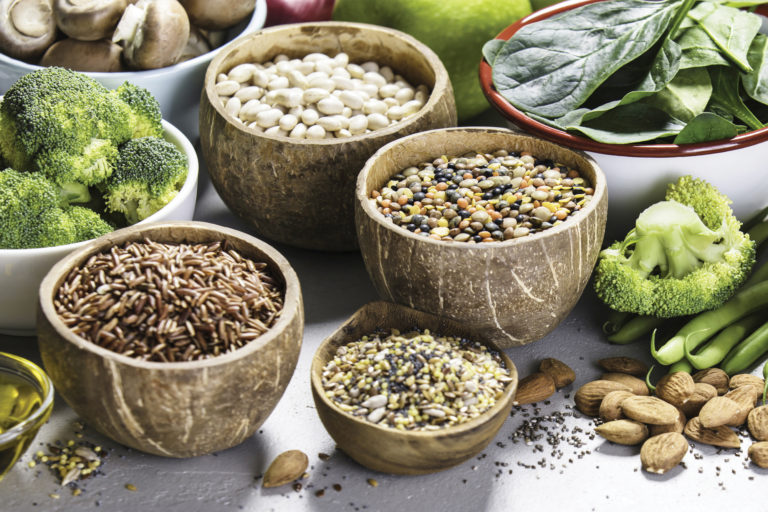
Vicki is a registered dietitian nutritionist, lifestyle nutrition expert, writer, culinary and media consultant and author of two books.
Fiber helps digestive health, but most people aren’t consuming enough
You’ve heard that you need to eat fiber — but why? While fiber helps with bowel regularity, it also has many other benefits throughout the body.
Fiber, which is resistant to digestion in the gastrointestinal tract, sweeps through the digestive system like an internal scrub brush. It also may help the body absorb nutrients and can impact blood pressure, cholesterol, blood sugar, and the balance of bacteria in the gut.
Having the right amount of fiber in the diet is especially important for older adults because it keeps the gastrointestinal tract healthy, promotes immune function and health, keeps the mind sharp, and helps maintain a healthy body weight.
Fiber facts
“There are many health benefits of meeting our dietary fiber needs, including improving blood cholesterol levels, which lowers the risk for heart disease, stroke, type 2 diabetes, and obesity,” says Colleen DeBoer, RD, clinical nutrition manager at Northwestern Medicine Lake Forest Hospital.
Fiber occurs naturally in vegetables, fruits, whole grains, nuts, seeds, beans, peas, and lentils. It’s also added to processed foods through ingredients such as locust bean gum, guar gum, and a prebiotic fiber called inulin.
However, even with all the evidence in favor of fiber, people still don’t consume enough. More than 90% of women and 97% of men do not meet the recommended intakes for dietary fiber, according to the latest Dietary Guidelines for Americans (DGAs). In fact, more than 85% of adults in the U.S. don’t get enough fruits, vegetables, and whole grains, which are prime sources of fiber.
Types of fiber 
There are two types of fiber: soluble and insoluble. Each serves a different purpose in the body. Most plant foods contain both types of fiber but are usually richer in one type than the other.
“Insoluble fiber is the fiber that promotes regularity of our gastrointestinal system and increases the bulk of stool, which can help those struggling with constipation,” DeBoer says.
Insoluble fiber reaches the colon where it resists being digested by gut bacteria. You’ll find insoluble fiber in cauliflower, wheat bran, nuts, seeds, potatoes, celery, corn, and green beans.
In contrast, soluble fiber dissolves in water, forming a gel-like substance that can do wonders for vascular health, reducing the risk of cardiovascular disease.
“Soluble fibers are known best to lower LDL (bad) cholesterol and glucose levels, as well as inflammation,” says Kristin A.R. Gustashaw, RDN, an advanced level dietitian at Rush University Medical Center.
Foods high in soluble fiber include broccoli, barley, whole oats, flaxseed, beans, peas, lentils, apples, citrus fruits, psyllium husk, and berries.
Prebiotic fiber — a type of soluble fiber — acts as food for thegood bacteria in our digestive system, which benefits the gut micro- biome and can ward off disease. Many foods, such as jicama, garlic, onions, and leeks, contain inulin. Other foods like flaxseeds, barley, and oats have their own specialized prebiotic fibers.
Filling up on fiber
Among its benefits, fiber can help people maintain a healthy weight. A large 2019 weight-loss study, the POUNDS (Preventing Overweight Using Novel Dietary Strategies) Lost study, analyzed the role that dietary fiber played for 345 overweight or obese participants on calorie-restricted diets. The findings revealed that dietary fiber promoted weight loss and dietary adherence.
“Fiber increases satiety levels, keeping you feeling fuller longer, which can help in achieving a healthy weight,” DeBoer says.
As with all nutrients, age and gender matter in the recommended daily allowances for dietary fiber. The DGAs recommend that women and men over age 50 aim for 22 grams and 28 grams of fiber per day, respectively.
But don’t rush to overdo fiber in your diet. “Anytime you are increasing your fiber intake, it is best to do it gradually,” DeBoer says. “Too much can cause unwanted gas, bloating, and cramping. Slowly increase over several weeks and remember to increase water intake when increasing fiber intake.” Also, space out fiber-filled carbohydrates throughout the day and eat a wide variety of high-fiber plant-based foods.
The average American is not eating enough fiber — but we should be. Older adults should prioritize fiber, as it can play a vital role in healthy aging and fending off chronic diseases.






